In an era where the very definition of luxury constantly evolves, the realm of designer fashion stands as a testament to timeless elegance and enduring allure. Amidst this glittering landscape, designer hats emerge as a quintessential emblem of style and sophistication. We delve into the opulent world of haute couture, exploring how iconic brands and visionary designers have continuously shaped our perceptions of luxury and exclusivity. Through a detailed examination of trends, craftsmanship, and innovation, this article unveils the secrets behind the magnetic appeal of designer fashion, highlighting how accessories like designer hats complement and elevate one’s style, embodying the essence of luxury in every stitch and silhouette.
The History of Luxury Fashion
Designer fashion, with its origins steeped in exclusivity and societal status, has long been a marker of luxury and class distinction. From the sumptuous fabrics of ancient royals to the haute couture that graces today’s runways, luxury brands have evolved, significantly influencing fashion trends and societal norms.
These brands, synonymous with quality and craftsmanship, not only dictate the ebb and flow of what’s in vogue but also reflect the changing dynamics of society’s elite, continually redefining what it means to be luxurious in the fabric of modern culture.
Defining Luxury in Modern Times
In the 21st century, the essence of luxury has transformed, embracing not just opulence but also sustainability and ethics. This modern interpretation goes beyond traditional extravagance, integrating mindful practices reflecting a growing awareness of environmental stewardship and social responsibility.
Luxury is now about the extravagance of a product and its journey towards creation, highlighting the importance of ethical sourcing and sustainable production. This shift marks a significant change in consumer values, where the true luxury lies in the harmony between indulgence and the well-being of our planet and its inhabitants.
The Top 20 Luxury Brands Today
Today’s top 20 luxury fashion brands showcase a blend of iconic heritage and modern innovation, spanning across countries like France, Italy, the UK, and the USA. These brands, such as Louis Vuitton, Gucci, and Chanel, are known for their unparalleled craftsmanship, innovative designs, and significant influence on global fashion trends. From high-end ready-to-wear to luxury leather goods and accessories, each brand offers unique styles and products that cater to the sophisticated tastes of luxury consumers worldwide.
- Louis Vuitton – Iconic French brand known for luxury leather goods and the famous LV monogram.
- Gucci – Italian luxury fashion house celebrated for its modern, high-quality designs.
- Saint Laurent – Offers modern takes on classic French glamour.
- Chanel – Synonymous with luxury and elegance, known for its timeless designs.
- Prada – Italian luxury brand loved for its innovative and stylish designs.
- Versace – Famous for bold, glamorous designs and iconic Medusa logo.
- Balenciaga – Combines heritage with innovative streetwear influences.
- Alexander McQueen – British brand known for its daring, avant-garde styles.
- Dior – French luxury brand with elegant, feminine designs.
- Burberry – British brand best known for its iconic trench coats.
- Ralph Lauren – Represents American luxury with a wide range of products.
- Givenchy – Combines modern sophistication with timeless elegance.
- Fendi – Italian luxury house famous for its craftsmanship and innovation.
- Hermes – Renowned for its quality leather goods and luxury items.
- Valentino – Italian brand known for its romantic and elegant designs.
- Giorgio Armani – Epitomizes Italian elegance and style.
- Balmain – Known for its luxurious, edgy, and innovative designs.
- Bottega Veneta – Celebrated for its discreet, no-logo elegance.
- Salvatore Ferragamo – Italian brand famous for its craftsmanship, especially in shoes.
- Dolce & Gabbana – Offers luxury with a distinct Italian flair.
Craftsmanship and Innovation
At the heart of luxury fashion lies an unyielding commitment to craftsmanship, a dedication to the meticulous creation of each piece, ensuring unparalleled quality and uniqueness. This traditional foundation, however, now seamlessly blends with the cutting edge of technological innovation.
Modern luxury brands are redefining the boundaries of design and functionality, incorporating advanced materials, digital design techniques, and even AI to push fashion into new realms of possibility. This marriage of old-world artisanal skills with futuristic technologies elevates luxury fashion’s aesthetic and tactile experience and reimagines its potential to enchant and innovate in equal measure.
Designer Hats as a Symbol of Luxury
Tracing their lineage through fashion’s tapestry, designer hats have evolved from mere head coverings to emblematic luxury icons. The bonnet, once a staple of modesty, has been transformed by visionary designers into a statement of luxury and individuality. This journey from functional to fashionable has cemented designer hats as indispensable accessories in luxury fashion. Their unique designs, quality materials, and craftsmanship not only showcase an individual’s style but also pay homage to a rich history of fashion innovation, making them a cherished component of high-end attire.
The Impact of Celebrity Culture and Social Media
In today’s digital age, celebrity culture and social media have become powerful forces in democratizing luxury fashion. Stars and influencers, adorned in the latest designer attire, serve as living billboards, their every outfit dissected and admired by millions. Amplified by platforms like Instagram and Twitter, this visibility has bridged the once-exclusive gap between high-end fashion and the general public.
As a result, luxury brands are no longer distant dreams confined to glossy magazine pages; they are now accessible aspirations, with every post and tweet bringing designer fashion right into the hands of a global audience eager to emulate their idols.
Challenges Facing the Luxury Fashion Industry
- Counterfeiting: Rampant counterfeiting dilutes brand value and erodes consumer trust, posing a significant challenge to luxury fashion brands trying to maintain exclusivity and authenticity.
- Digital Transformation: Adapting to the digital era, including e-commerce and digital marketing, while preserving the tactile and personalized experience luxury shoppers expect.
- Sustainability Pressures: Increasing consumer demand for ethical and sustainable practices requires luxury brands to rethink production processes, supply chains, and materials, often at higher costs.
- Market Saturation: The luxury market is becoming increasingly crowded, making it harder for brands to stand out and maintain their allure amidst a sea of competitors.
- Economic Fluctuations: Global economic instability and fluctuating markets can impact consumer spending on luxury goods, affecting sales and profitability.
- Changing Consumer Preferences: The shift towards casual wear and the decline in formal attire demand, coupled with a younger generation’s different values and expectations, challenges traditional luxury fashion norms.
- Technological Innovation: Keeping pace with rapid technological advancements and integrating these into products and experiences without losing the essence of luxury.
- Globalization vs. Localization: Balancing global brand consistency with adapting to local tastes, cultures, and consumer behaviors in different markets.
- Privacy and Data Security: As luxury brands delve deeper into digital, the challenge of protecting customer data and ensuring privacy becomes paramount.
- Authenticity and Heritage Preservation: Maintaining the brand’s heritage and authenticity while innovating and staying relevant in a fast-paced fashion landscape.
The Future of Luxury Fashion
As we peer into the horizon of luxury fashion, a dynamic future unfolds, shaped by a confluence of emerging trends and societal shifts. The industry is poised to transcend traditional boundaries, integrating innovative technologies with sustainable practices to redefine what it means to be truly luxurious. Personalization and digitalization are set to become more prevalent, offering bespoke experiences that cater to the individual desires of the discerning consumer.
Moreover, as societal values continue to evolve towards inclusivity and environmental responsibility, luxury brands will increasingly champion ethical production and transparency. This evolution reflects a broader understanding of luxury, which values the significance of the stories behind the garments as much as their aesthetic appeal. In this future, luxury fashion adorns the body and resonates with the spirit of the times, mirroring the complexities and aspirations of a rapidly changing world.
Conclusion
In a world saturated with mass-produced trends, designer hats offer a refreshing sanctuary of quality, artistry, and individuality. They are more than just accessories; they are personal style statements, testaments to generations of craftsmanship, and investments in timeless elegance. So, embrace the irresistible charm of designer hats, and let them redefine your luxury narrative.



